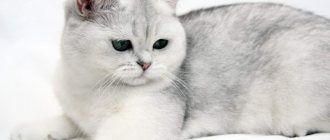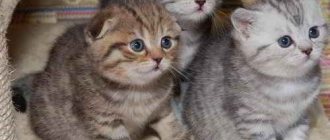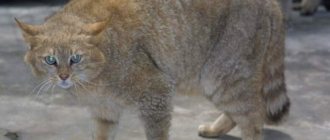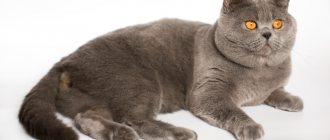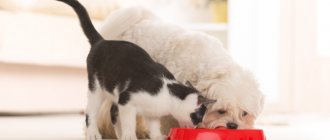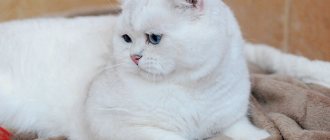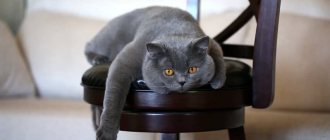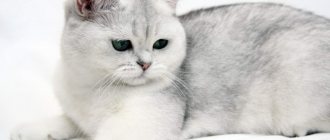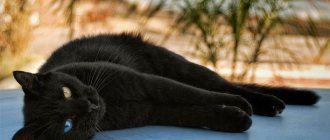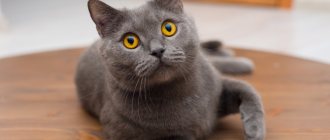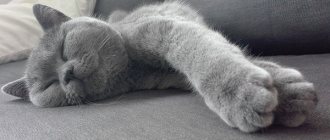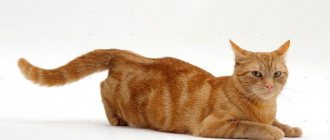- Posted by Ekaterina Gonina
- Date: December 18, 2018
British and Scottish cats are often confused with each other. The thing is that they have common ancestors. For a long time, breeds were allowed to be crossed to improve conformation and impart characteristic body features. However, now this is not welcome, and the cats are very different in appearance and habits.
- 2 External differences between the British and Scots
- 3 Differences in character
- 4 Differences in care
- 5 So who is better?
- 6 Owner reviews
Choosing a pet
Which cat to choose: British or Scottish? It all depends on the preferences of the owners. For a noisy family with children, a Scottish dog is more suitable, but these active animals require attention from the owner. Therefore, if everyone in the family works and is absent for a long time, this lifestyle will be more to the liking of a British woman. Well, and the most important thing is to listen to your heart. Sometimes one kitten can captivate with its charm so that all logical arguments fade into the background. The main thing is to remain responsible and soberly assess your capabilities: whether you can provide the animal with suitable conditions.
Which cats are better: British or Scottish? There is no clear answer to this question. After all, “better” or “worse” are subjective concepts. The main thing is to carefully choose an animal, study its pedigree and exclude the presence of genetic abnormalities, especially when it comes to Scottish cats.
Yandex.RTB RA-272370-2 –>
Scottish Fold cats and cats of this breed are distinguished by their friendliness and sociability - this is expressed in the fact that they are constantly looking for company: either people or other pets. Also, cats of this breed, according to their cat habit, are always loyal and affectionate. When choosing a pure breed kitten, we usually encounter the concept of “kennel”, shrouded in mystery.
Many buyers don't understand what this concept really means.
Despite the fact that for a successful choice of a kitten it is quite important to understand exactly what this means
British cats
The British Blue cat, of course, does not have a sky-colored skin. Its color is still grey. It is called blue, probably because one of the cat experts saw a bluish tint in it. The description of the British cat suggests solidity and solidity. These animals have a massive, dense body and a wide round head. This body type combined with their plush fur gives them the appearance of a soft toy that you want to cuddle. But you have to be careful. The character of these cats varies. They are always characterized by aristocracy, and they always know their worth. Therefore, such a pussy can be both soft and affectionate, and wayward and give only small portions of attention to its owners. Much depends on the upbringing of the kitten.
The colors of British cats come in different colors. In addition to the classic gray cats, there are, for example, red and tabby cats.
British kittens are born with blue eyes. Only by 4-5 months do their eyes acquire a characteristic color, and it is fixed only by one year. Amber-yellow eyes look bright against the background of a gray skin. True, this is not the only possible description of the British cat. Their eyes also come in other colors. It depends on the coat color. For example, eyes can be blue, golden or even green. This breed has developed sexual dimorphism - cats are noticeably larger than cats, they are more muscular and even have differences in the shape of their faces. Cats, despite their large build, are smaller and more graceful than cats and even have a softer facial expression and neat features.
Character
British and Scottish cats have different personalities, this is noted by all pet owners. The former have a phlegmatic temperament; they are more reserved and independent, and do not need constant communication and games. They are more adapted to loneliness and will begin to affect their owners only when they themselves want it. Cats of this breed do not like when anything is done against their will. If the owner picks up the animal, there is a high probability that it will try to break free and run away.
Regardless of variety, Scots are more sociable. They love to spend time with their owners, play and misbehave
If for some reason they are not paid attention to for a while, they begin to touch people themselves, touching them with their paws, rubbing against their legs and purring. Get along well with children and other pets
At the same time, they sense the owner’s mood well: if he is not in a good mood, the animal will not bother, and when the mood is not very good, he will try to cheer him up. Cats tolerate squeezing well: the pet will not break out or scratch. But as soon as he feels freedom, he will probably run away to a secluded place.
Differences in Personality
Scottish cats have a gentle character. They are more willing to compromise than the British. The Scots are affectionate and sociable, they follow the one they have chosen as the owner, and enjoy contact with family members. They often find a common language with children, but this does not apply to all representatives of the breed. Scottish cats love active games, travel and exhibitions. They will not refuse to walk outside if the owner takes care of safety and puts a harness on the pet.
Scottish cats may stand on their hind legs when they are curious or want to attract their owner's attention.
The British are called aristocrats. They are calm and sedate, sedentary and majestic. They are more inclined to observe what is happening than to participate in anything. The British are not very demanding: if they are hungry, they will not ask loudly, but will wait silently. They are unobtrusive and are well suited for those people who do not like their pets to attract attention.
Scottish cats have amazing artistry, flexibility and charisma: they even like to sit like a human, not like a cat.
My sister has a British cat, and I have a Scottish cat at home. My favorite is not as affectionate as in the descriptions of the breed: she can bite if she doesn’t like something, and she doesn’t like to sit in your arms. Before castration, the cat often hid from me or sat in her house. But now she often comes up and asks to pet her and doesn’t mind if I do it spontaneously, but my sister’s cat doesn’t like unnecessary attention to herself. When guests arrive, he climbs up and sits there. Mine loves meeting new people, although she spends a long time sniffing around. Both my cat and my sister’s cat don’t like children: they hide behind the furniture. Mine, however, will hiss at first and may bite. The Briton is more patient, but he clearly doesn’t like intrusiveness. From my experience, I will say that Scots are better suited for those who want a cat as a companion. The British make contact and play with pleasure, but it is difficult to expect signs of attention and devotion from them.
Breeding Features
Both Britons and Scots reach puberty at 6-7 months, like most cats. But this age is considered still insufficient to safely bear and give birth to kittens. Therefore, it is better to carry out the first mating at the age of about 1 year. The British are bred only with the British, but the Scots are mated as we already mentioned today: one parent is taken with a Scottish Fold, and the other with a straight ear.
Therefore, the presence of Straight-Eared Scots is simply necessary for the continuous reproduction of this breed. Moreover, Scots with regular ears can also take part in exhibitions, but they are unlikely to receive a title. And one more thing: Britons and Scots are never bred; mixing two different breeds is not permissible, unless you are a supporter of genetic experiments.
Features of breeds
British and Scottish cats are very popular all over the world, the difference between which is not particularly visible to a non-specialist, but still there are certain differences, and those who want to purchase a representative of a certain breed need to know these features.
Very often, the British Blue cat becomes the standard of choice for the buyer. In fact, she, of course, has nothing to do with the heavenly color, just the exquisite gray color of her coat speaks of her belonging to the breed and “blue blood”. The rather powerful body and indescribable expression of the face become one of the most distinctive features of these cats, because a wide variety of shade combinations are actively coming into fashion to replace the gray color of the coat. For example, in an advertisement for cat food, a very funny tabby kitten is filmed. So, this is also a representative of the British, and much more popular today than the classic British blue cat.
So different…
Experts who evaluate cats participating in exhibitions can add many more points to this list of differences. But they will most likely be applicable to the best representatives of the breed - show class cats.
For an ordinary person, to distinguish a Briton from a Scot, what we have listed is quite enough. Even if you see a straight-eared Scottish cat - a Scottish Straight - in front of you, you can distinguish him by many additional characteristics, about which read more.
The difference between a British cat and a Scottish cat
It is difficult for a person who is not competent in this matter to distinguish these two breeds from each other. Let's start with the tail. In the Scottish breed it is clearly longer than in the British cat. They are also easy to recognize by the shape of their ears. The British breed is famous for its persistent, straight and slightly rounded ears, while the Scots have both pointed ears and flattened ears.
And finally, the differences are in the shape of their heads. British cats have a round head with pronounced cheekbones and side cheeks. And the Scots can boast of an oval face and a noticeable chin.
The difference between British and Scottish cats in character and color
The British are more friendly to children, although they do not show it actively, because they are always calm and love solitude. But the cat will not refuse to play with your child. As for the Scottish cat, she can show her displeasure in front of the child and quickly hide in the nearest secluded places.
It's very easy to tell a Brit from a Scot using height. The latter are very afraid of heights, and therefore will be very nervous to the point of extremes.
It will be difficult for a non-professional to distinguish a British cat from a Scottish cat by color. Because both have similar colors. It will be easy to distinguish the subspecies of the Scottish cat - Straight, which has a unique pockmarked color.
British or Scottish cat, which one to choose?
These two breeds are very similar, both in color and in character. The choice depends on the goals pursued by the buyer. For those who just want to buy themselves a faithful friend, there is no difference. You can choose one or another cat.
Therefore, for the average buyer who cannot decide between two breeds, it is proposed to choose only between minor body structures and color, which in most cases are the same.
At first glance, it seems that the British and the Scots are easy to distinguish, because some have straight ears, while others have bent ears, which is why the breed is called the Scottish Fold. But the catch is that straight-eared kittens are always born in Scottish litters, since crossing two fold-eared cats carries a high genetic risk.
Straight-eared kittens are called straights, and although they are purebred Scots, it is not at all easy to distinguish them from the British. However, experts name a whole list of traits that make up the difference between British cats and Scottish ones, and the photos that we have collected will help you figure out who is who in the cat world.
Mutant genes and modifier genes
In addition to the “main” genes that are responsible for certain traits, there are modifier genes.
It is they who determine to what extent, when and in which individuals the consequences of the inclusion of a mutant DNA section in the chromosome will manifest themselves.
Suppose that in violation of all the rules, a British fold cat was born.
This could only happen in two cases:
- Both mother and father are carriers of the dominant fold gene (denoted Fd). Such a crossing is called homozygous (from “homo” - the same). At the same time, in order for the kitten to be at least a little British, and not Scottish, one of the parents (any) must be British. This combination in itself (British + Scots) today makes it impossible for the official birth of a British Fold kitten.
GENOTYPE OF THE KITTEN 1. Based on the shape of the ears, the British Fold baby has the genotype FdFd (two identical genes received from the father and mother).
- Only one of the parents has special ears. Let the father be a Scottish Fold (Fd), and the mother be a British cat with normal ears (fd). If we do not take into account that the kittens, by definition, will be mixed breeds, then such a heterozygous (“hetero” - different) mating is more successful than fold + fold, in which 1/4 of the babies are not viable.
KITTEN GENOTYPE 2. He received Fd from his father, and fd from his mother. The total result is a relatively safe combination of Fdfd, characteristic of purebred Scottish Fold cats.
In both cases, we cannot predict whether the modifier genes will work or what the nature of their effect will be. Breeders' observations are as follows:
- Strongly pressed ears are often inherited along with a short, sedentary tail. If there are too many such sires in the pedigree (trait accumulation), one day there may be a sharp deterioration in the quality and viability of the offspring;
- Some folds' ears sometimes stand up and look like straights', but genetically they remain droopy. This is a clear example of the influence of modifiers;
- It is rare to combine a good tail and good ears. It is extremely rare to find producers who do not carry the accumulated trait in the pedigree;
- It is possible that modifier genes can also influence the character of cats with floppy ears.
Something else interesting: Sphynx cat breed
British and Scots: comparison of characters
Despite common ancestors, cats of related breeds differ greatly in behavior. Therefore, this is what you should start from when choosing a pet.
1) The British are calmer. They don't like active entertainment. Long caresses are also not about them, so it’s rare that my lord or milady will sit on the owner’s lap and not run away somewhere.
The Scots, on the contrary, completely frolic. They love children very much and you can cuddle them for hours, as the cat only experiences genuine pleasure. Thus, for a family with children, the Scottish Fold is probably better suited.
2) Both breeds do not show aggression. In the event of a stressful situation, both types of cats do not rush at the offender, trying to bite and scratch him, but run away and hide in hard-to-reach corners. This quality is also suitable for families with children. Because the owners can be sure that the pet will not harm even the most daring child in handling the cat.
3) An interesting behavioral feature of Scottish cats is that they periodically stand on their hind legs and stand like that for some time. This is by no means fun for the cat, but a procedure necessary for its health, because in this way the animal straightens its spine. They also like to sit on their hind legs, like brave watchdogs.
3) Not all cats like to climb up. An example of this is the Scots, who never sit higher than the windowsill. Representatives of a related breed, on the contrary, behave in this regard, no different from other desperate brothers: they climb anywhere and are very fond of heights.
So, a cat’s character plays an important role, so in order for the animal not to cause concern to the owner, when choosing a pet, you should focus not only on appearance, but also on behavioral characteristics.
Differences in body structure
We can say that today's acquaintances, British and Scottish cats, are sisters. However, even such close relatives have their own differences and characteristics - more on them below.
Torso and limbs
The British have a more massive, squat and rounded body (this is noticeable in the photo below). The Scots seem to be “fit”. But at the same time, both cats look quite sporty. The paws of the British are shorter and thicker, while the paws of the Scots are longer and thinner. But both breeds have plump and round paw pads.
Head and ears
Among the British, it looks larger than among the Scots, due to the fact that the cheekbones and jaw of the latter are more pronounced. Both breeds have wide, round eyes, although in the Scots they sometimes appear larger, largely due to the fact that they contrast with the miniature ears. By the way, the combination of huge eyes coupled with small ears reminds many of the “owl” expression of the face of the Scots. They were also called the owners of “babyface”.
An infinitely cute video starring small kittens of the Scottish and British breeds, for your viewing further!
Tail
May assist in identifying breeds from the British continent. In Scottish, it is of medium thickness and length and quite flexible, but in purebred British, the tail is usually thicker and shorter.
External differences between the British and Scots
Most often, when people talk about the Scottish Fold cat, they mean the Scottish Fold. This is one of the four main varieties of the breed. Scottish Folds have small ears, which ideally should not extend beyond the contours of the head. This appearance is due to a mutation associated with cartilage. The more folds a cat has in its ears, the more they are bent towards the head. There are animals with a weak crease, but they, as a rule, are not allowed for breeding and become ordinary pets.
Apart from the ears, only attentive people will notice the differences in the shape of the muzzle: the British have a more massive skull
Scottish Straights have straight ears, but, unlike representatives of the British breed, the distance between them is less. Their ears appear narrower at the base. Additionally, Highland Folds and Highland Straights are also distinguished. They differ from their counterparts in having longer hair.
Thanks to the fluffy fur coat, the Highland Straight appears more massive
Representatives of the Scottish and British breeds differ in the shape and size of the head. The first ones are more miniature: their heads are rounded, their chin is strong, and their jaws are strong. The British have better developed cheekbones. The cheeks stand out. The head has a more oval, elongated shape.
British cats look much stronger due to their massive necks.
In terms of physique, the British look stronger and more compact. The Scots are physically fit, but they are rather graceful and agile. The British have a massive and rounded silhouette due to powerful paws. Scots have slimmer and longer paws. This makes them look taller and lighter.
Despite the fact that the Scots and the British are approximately the same in size, the former seem taller due to their lightness and fragility
In the British, the tail length is only 2/3 of the body length. The Scots have more massive tails, but the main requirement for them is mobility. This is due to a special mutation in the cartilage, which can cause vertebral fusion, disability and death. Even if the animal is in normal health, due to an inactive tail, it will most likely be removed from breeding, since it can pass on the defective gene to its offspring.
A short tail, altered gait, inactivity, inability to jump high and growths on the hind legs of a Scotsman are reasons to consult a veterinarian
Shorthaired British and Scottish shorthairs are almost identical in their fur coats. Only experienced breeders will detect by touch that the former have thicker and denser fur, while the latter have fluffy fur. Highlands have a silky coat with a dense undercoat. They have a long collar on their neck, and their tail resembles a fan.
Crossbreeding
What would a cross between a British and Scottish cat look like? It must be understood that interbreed mating of British and Scots is prohibited. At first, they were regularly crossed - the British diluted the “loop-eared” genes, preventing developmental anomalies from appearing. But over time, two separate breeds were identified. Scottish Straights have been recognized as distinct from the British, and these cats interbreed well with Folds. Straight-eared Scots also carry the gene for lop ears
Why is this important? Modern standards for the breed have become stricter. Initially, these cats' ears were only slightly tilted forward
At the moment, it is required that they fit as tightly as possible to the head and have folds. After all, “fold” in English is a fold! Crossing with the British leads to the fact that the ears are too large and quite noticeably extending from the head. But this is not the biggest problem. The lightweight skeleton of the Scots, compared to their British ancestors, serves an important purpose. The shape of the ears of these cats is due to a mutation in the cartilage tissue. Having light bones, these cats do not suffer at all from their mutation, but the more massive build of the British can provoke anomalies in them. In addition, blurring the boundaries of rocks simply does not make sense.
And to the question of whether a fold cat is a British or Scottish breed, the answer is obvious. British cats are not fold-eared, and advertisements for the sale of British fold-eared cats are simply illiterate. This trait is unique to the Scots.
Is it possible to breed a British cat with a Scottish cat?
Video: Why are Scots and Brits different breeds? What is the difference? Why can't they crossbreed?
The Scottish cat breed is young. At the very beginning of the breeding, it was crossed with the British cat, but studies have shown that this is harmful to both types of cat breeds.
Now, according to new requirements, in order to preserve the pedigree of British kittens , a cat and a male cat of the same color are selected for mating.
It is also impossible to breed fold-eared cats and female cats together - this leads to kittens being born with bone abnormalities (curvature of the spine, crooked legs, thickened tail). Now Scottish Folds and Scottish Straights are being bred together, and the offspring are half like the dad and half like the mom.
Differences between British and Scottish Fold according to international standards
| British Shorthair | Scottish Fold | |
| Ears | Rounded at the tips, wide at the base. Definitely short. | The ears are small, but droop down and forward. Together with the head they should form a triangle. |
| Torso | We can say that the chest is wide, like that of a good fighting dog. | More rounded, also athletic, but more even from the shoulders to the tail. |
| Paws | Powerful legs on a small body, they are not long, so the animal looks massive. | The average length of the paws, which are proportional to the body. More slender than the British. |
| Head | The cheeks stand out against the background of the round head. | Something like an owl. The lower part with the chin is well developed. |
| Nose | No bending when transitioning from the forehead. It should have a depression at the forehead. | Voluminous and short nose with widening towards the base. |
| Tail | Relatively short and thick, rounded towards the end. | Medium length and thickness, very mobile, pointed towards the tip. |
| Eyes | Round like buttons. They are far away from each other | Forever surprised and greatly opened up. |
| Wool | Plush, but feels firmer. | The soft one also has a good undercoat and a “plush” characteristic; it can be long and not close-lying. |
World-recognized breeds immediately acquire standards, according to which judging takes place at exhibitions. The selection of a kitten should also be based on these criteria. Compliance with them indicates the purebredness of a representative of a particular species.
Below are the CFA standards for the two species considered.
| British | Scottish fold | |
| Body | The body of an athlete in a cat role. The tail is long and not very mobile. Its tip should be rounded. Short legs. | Round and medium, strong. The legs are not short, which resemble the legs of a slender model. The tail is medium or long. Tail flexibility is high. The end must be pointed. |
| Head | A strong chin stands out on a round head. Small nose. Well defined cheeks. | Well rounded with a strong lower part. Set low on the neck. Well defined cheeks, more so in boys. Let's say a small stop on the nose. |
| Ears | Medium height, wide towards the bottom. They should also be rounded at the tips. | Small and bent. The tips look not only down, but also forward immediately. |
| Eyes | Large, very open, different colors. | Constantly surprised facial expression. Cats with different eyes are allowed, but only white or bicolor. |
| Wool | Short with well-developed undercoat. The texture is not woolly, but fleecy. | Dense, plush, length from short to slightly elongated. Soft. The texture depends on the season, place of residence and color. |
| Color | Any color and with points (spots, stripes), except for white splashes. | Any natural colors (blue, white, black, striped) |
These standards also talk about defects that could disqualify a cat. This means that their professional breeding will become impossible. For the British, this is the presence of a stop at the transition from the forehead to the nose. For Scottish Folds, prominent brow ridges, a short and rigid tail with a hook, splayed toes, lilac, chocolate or a combination of both and white.
Both of these breeds are great friends and adapt to any environment. They are friendly and easy to care for. When choosing a kitten, decide whether you want a more massive and larger cat (British) or a plush friend with higher legs and a less muscular body (Scottish Fold).
Video on the topic
Cats are one of the most popular pets. The entire Internet is replete with photographs of cute faces. Some people prefer purebred cats, others pick up furry friends on the street and do not attach importance to their origin. Those who want to buy a purebred cat or male cat simply need to become thoroughly familiar with the different breeds of these animals. Some people are confused by the similarities between the two breeds - British and Scottish. What is the difference? How are they different from the British ones? Sometimes on specialized websites and in newspapers you can find an advertisement for the sale of a British Fold kitten. Is this possible?
How I chose a cat. Part 2. British vs Scots
When we first came to the cat show, we saw that there were two breeds similar to the kitty from the Whiskas ad - the British Shorthair and the Scottish Straight (these are brothers of the Scottish Fold, who did not pass on the fold gene).
To a greater extent, the similarity comes from the tabby color - when on the main light background there is a contrasting pattern in the form of dark spots (spotted tabby), streaks (marbled tabby) or stripes (tiger tabby). I have seen both marbled and spotted ones in advertisements. The color of the kittens from the Whiskas advertisement is silver tabby, i.e. black drawings on a silver background. Very beautiful and contrasting cool colors.
But both the British and the Scots have a round face, cheeks and plush fur. We could distinguish the Scottish Folds from the British only by their ears)) And if it was a kitten with straight ears, then every time we were mistaken when asking if it was British. We could not understand what the difference was between these breeds, and persistently asked breeders at exhibitions. But the answers were predictable - the British owners praised this breed, and the Scottish owners praised theirs. Each sandpiper praises its own swamp, something like that.
In our opinion, the breeds are very similar, and for good reason. It turns out that for a long time the British and Scots were mixed together, i.e. A straight-eared kitten born from a mating between a Briton and a Scotsman was recorded as a Briton. After 2004, such a kitten is recorded as a Scottish Straight.
But still there are differences. Although, I honestly admit, they did not influence the choice of a breeder or breed)) In case someone also wondered about the differences between the British and straight-eared Scots, I will tell you the little that I managed to find out.
Of course, the best thing was to rustle through the breed standards, find descriptions of one and the other there and then compare them. But such texts are difficult to digest; it is much easier and clearer to look at the pictures
